If you've got a full-length mirror, a glass door or a similar reflective surface at home, you could be looking at your own personal golf coach. Once you understand proper fundamentals, the mirror can help you diagnose and repair flaws while reinforcing your strengths.
As simple as it seems to judge your ball position, posture and takeaway from the address position, what you believe you're doing and what you're actually doing may be two different things. That's why a mirror can be extremely helpful. No, you can't take it with you to the golf course, but practicing correct fundamentals at home will instill a sense of what the proper positions look and feel like sans mirror.
This article examines the stance and swing positions you can check while directly facing a mirror.Part II explains what to look for in a side view. A third installment covers the putting setup and stroke.
Before starting, make sure you've got ample room to make a full swing. Golf is expensive enough without broken lamps to replace. And remember that a mirror is no substitute for an actual PGA-certified instructor, who can watch you make full-speed swings and study your ball flight for clues to any flaws.
Here's what to observe when addressing the ball (real or imaginary) with a mirror in front of you; instructions are for right-handed golfers, so lefties may simply reverse them. For precise alignment, place a club along the line of your feet, parallel to the mirror:
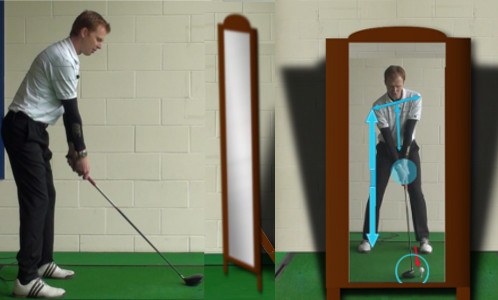
- Stance width: Most important with the driver, when the insides of the feet should line up with the outsides of the shoulders (“shoulder width”). The stance narrows with progressively shorter clubs.
- Ball position: With the driver, the ball should be directly opposite your left heel. At the other end of the spectrum, wedges are played approximately in the center of your stance.
- Weight distribution: Should be evenly placed on your right and left feet. With the driver, a little more weight on the right side (55-60%) is recommended.
- Shaft angle/hand position: Driver—Shaft should be perpendicular to the ground, so the hands are in line with the clubhead just behind the ball. Irons—Shaft should lean slightly forward, toward the target, with the hands ahead of the ball.
- Spine tilt: Your upper body should lean a touch to the right; some teachers believe a 5° tilt is ideal. Determine your tilt by checking your sternum.
- Takeaway – maintaining the triangle: The arms, wrists and hands should move away from the ball as one unit (aka “the triangle”). Watch your takeaway for signs of an early wrist hinge.
- Backswing – hands at hip height: At this point, the club shaft should be parallel to the ground; slightly above or below parallel is okay. The club's toe should point upward. If it points too far in front of you, the clubface is closed relative to the target line; pointing behind you means it's open.
- Backswing – left arm parallel to ground: With your wrists cocked, the shaft should point upward to some degree (vs. lining up with the left arm). The angle between shaft and left arm may vary at this position, but anything from 45-90° is generally acceptable.
- At the top – shoulder and hip rotation: With longer clubs (driver through mid-irons), the shoulders should have turned 90° to the target line (mirror), with the hips at or near 45°. For short irons, rotation is a bit less.
- At the top – hands, arms and club: With longer clubs (driver through mid-irons), a shaft that's parallel to the ground is ideal but by no means a necessity. The left arm should be relatively straight, with the hands extended well away from the head.
Next, it's on to the takeaway and backswing:
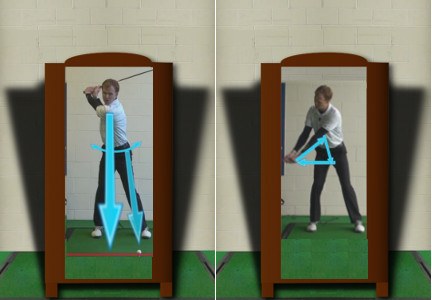
At the top – weight distribution: The majority of your weight should be on your right side, poised in the center or inside of the right foot.
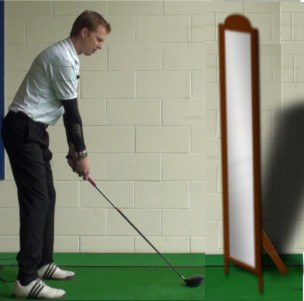
Mirror Reflection Can Guide You to Correct Fundamentals – Part 1
One of the inherent challenges you will face when trying to improve your golf swing is the fact that you can't really see yourself as you swing. Sure, you can look down and see your feet – and even your hands for part of the swing – but you should really be looking at the ball while the club is in motion. Many players decide just to rely on their own 'feel' during the swing to figure out what is going right, and what is going wrong.
Unfortunately, your feel can lie. If you have ever watched your swing back on video, you already know that what you are actually doing may not look much like what you think you are doing. Many golfers are shocked to see what their swing looks like after believing it looked a certain way for many years. If you have never before recorded your swing on video and watched it back, try to do so in the near future. You may be quite surprised to see what you look like in action.
Of course, it can be difficult to frequently record your swing when practicing. You might not have the right equipment to get set up for such an operation, and using video can be time consuming. Rather than dealing with the complications that video can introduce, you may wish to turn to the use of a mirror. Many driving ranges have one or two hitting stations equipped with full-length mirrors so you can check on some of your swing fundamentals prior to hitting your shots. You won't be able to watch yourself in the mirror while you swing, obviously, but using the mirror to check up on your address fundamentals can be highly beneficial.
It should be pointed out here that we are not suggesting you should give up on the idea of using video to improve your game. Recording your swing on video is a powerful tool, and it is recommended from time to time. Our point is this – it can quickly become burdensome to attempt to use video during each and every practice session. Instead, consider using video on occasion, while using the assistance of a mirror more regularly. The combination of these two techniques can help you improve your game rapidly.
So what about golf lessons? Taking lessons from a professional instructor is something that belongs in its own category. Yes, lessons can be greatly helpful, especially for new players who need to learn the fundamentals from a trusted source. However, few people can afford to take lessons each time they go to the driving range. That means you are going to be on your own quite often, which means you may want some help in seeing exactly how you are doing. Once you learn how to use a mirror to master your fundamentals, you may wonder how you went so long without this handy tool on your side.
All of the content below is based on a right-handed golfer. If you happen to play left-handed, please take a moment to reverse the directions as necessary.
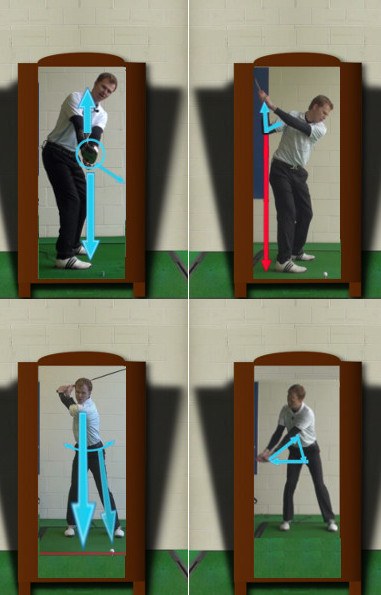
Getting in Position
Mirrors can lie. While they seem so simple on the surface – they offer a reflection of whatever is in front of them at the time – you can get a distorted image if you don't use the mirror properly. So, the first thing to understand when thinking about using a mirror to improve your golf game is where you need to stand in order to receive accurate information. Standing out of position in front of a mirror can lead you down the wrong path in a hurry.
There are two general positions from which you can use a mirror on the driving range – the down-the-line angle, and the face-on angle. Each of these angles is exactly as it sounds. The down-the-line angle is going to show you a reflection of yourself at address from an extension of the target line. The mirror will be placed to your right (as you stand over the ball), so you will need to turn your head to the right to see how your body is positioned. For a face-on look, you'll put the mirror directly in front of you, so you can look up from address and see yourself.
Each of these perspectives will have its own information to offer about the status of your stance as you get ready to swing. Let's take a closer look at why you would use each of these two perspectives.
- Down-the-line. When you take a look at your address position from the down-the-line view, you are going to be able to observe a few things. First, you will be able to see how well you are aligned with the target. This is crucial. Countless amateur golfers struggle to properly aim the club face at the target they have selected for a given shot. When they hit the shot – and it does not go in the right direction – these players usually blame their swings rather than their alignment. By checking on your alignment in a mirror, you can eliminate this problem as a possibility. Also, you will be able to get a great look at your posture from the down-the-line view. Are your knees flexed properly? Is your back straight, your chin up, and your backside sticking out behind you? It's hard to tell if you have formed a solid posture without being able to take a look for yourself.
- Face-on. You will be evaluating completely different points when you look face-on instead of down-the-line. The first thing you will want to check when using this view is balance. Do you look like you are properly balanced with your weight evenly distributed between your two feet? If not, you may need to make an adjustment to your stance. You don't want to be leaning to either side before starting your swing. Another point you can check here is the position of your hands as they relate to the ball. For an iron shot, you usually want to set your hands just slightly in front of the ball (closer to the hole). For a driver swing, you will probably want to position your hands in line with the golf ball. You might be able to get a decent view of this point from your perspective at address, but it will be easier to judge when looking in the mirror. Finally, one last piece of information you can gather from the face-on view is the angle of your shoulders. Most golfers will play best when they set the right shoulder slightly lower than the left. If you have it the other way around – with your left shoulder lower than your right – a steep swing will be the likely outcome.
You can learn a lot about your golf game by using both of these angles to your advantage. Once you get comfortable with the process of using a mirror, you will be able to quickly spot any problems which may have popped up in your pre-swing technique. Get into the habit of checking on your stance from time to time just to make sure you keep your address position in a good place over the long run.
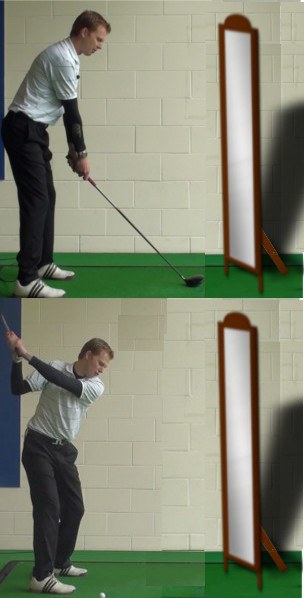
Incorporating a Mirror into Your Practice Routine
If you have access to a driving range which has a mirror or two available for you to use, it would be a good idea to incorporate some mirror work into your regular practice sessions. This may be a little bit intimidating at first, but it is actually quite simple once you get the hang of it. The address position is an incredibly important part of your technique overall, and using a mirror is an easy way to keep tabs on how your stance is doing from day to day.
To get started, consider doing a few minutes of work in front of a mirror without actually hitting any shots. Simply take one of your clubs from the bag – a mid-iron works great for this purpose – and practice taking your stance over and over again. You will just take your stance, look at the mirror to check on your positions, then start over. You can use both the face-on and down-the-line angles to see how you are doing. Obviously, you should make any corrections which are needed as you go, and make note of points that seem to be a recurring problem.
Once you have completed a few minutes of strictly mirror work, it will be time to actually hit some shots. Obviously, you need to make sure the mirror is safely out of the way when hitting shots, so you can make your swings comfortably without any risk of hitting the mirror itself. When you are going to hit shots, you will follow the same general process as above. Take your stance, then look at the mirror to check on your positions. If you are happy with what you see, look back down at the ball and make a swing. Repeat this process over and over again until you are ready to move on to another part of your practice session. Try using a variety of clubs, as some players will have a great stance with one club only to be out of position with another.
Some driving range facilities have fixed mirrors, which are mounted in place in front of specific hitting stations. Others have portable mirrors, which have been mounted on frames that can be taken to various spots around the facility. Either way, you want to be considerate of other golfers and avoid dominating the mirrors while you are practicing. There is a chance that someone else on the range will want to use the mirror for a while, so do your work and then move on to other things. There is no need to use a mirror for every single shot that you hit, as you should be able to get into a good pattern with your stance after a bit of practice time. It makes sense to use the mirror at the start of your practice session, if possible, to establish a great stance for the day. Once you are happy with your position, move on to other things and check back in with the mirror before your next practice session.





